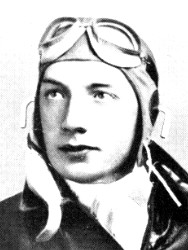After graduating from high school in 1938, Darrell Lindsey attended Buena Vista University in Storm Lake, Iowa, for one year before transferring to Drake University in Des Moines. He enlisted in the U.S. Army in 1942, receiving his wings and commission in August 1942. Killed in the action that earned him the Medal of Honor, his remains were not recovered and he was listed as missing in action.

–
Cemetery:
Awards Received
-

Medal of Honor
-
Medal of Honor
Service:
United States Army Air ForcesRank:
Captain (Air Corps)Batallion:
585th Bombardment SquadronRegiment:
394th Bombardment Group (M)Division:
9th Air ForceAction Date:
August 9, 1944
War Department, General Orders No. 43, May 30, 1945The President of the United States of America, in the name of Congress, takes pride in presenting the Medal of Honor (Posthumously) to Captain (Air Corps) Darrell Robins Lindsey (ASN: 0-729031), United States Army Air Forces, for conspicuous gallantry and intrepidity in action above and beyond the call of duty while serving with the 585th Bombardment Squadron, 394th Bombardment Group (M), Ninth Air Force. On 9 August 1944, Captain Lindsey led a formation of 30 B-26 medium bombers in a hazardous mission to destroy the strategic enemy held L’lsle Adam railroad bridge over the Seine in occupied France. With most of the bridges over the Seine destroyed, the heavily fortified L’Isle Adam bridge was of inestimable value to the enemy in moving troops, supplies, and equipment to Paris. Captain Lindsey was fully aware of the fierce resistance that would be encountered. Shortly after reaching enemy territory the formation was buffeted with heavy and accurate anti-aircraft fire. By skillful evasive action, Captain Lindsey was able to elude much of the enemy flak, but just before entering the bombing run his B-26 was peppered with holes. During the bombing run the enemy fire was even more intense, and Captain Lindsey’s right engine received a direct hit and burst into flames. Despite the fact that his ship was hurled out of formation by the violence of the concussion, Captain Lindsey brilliantly maneuvered back into the lead position without disrupting the flight. Fully aware that the gasoline tanks might explode at any moment, Captain Lindsey gallantly elected to continue the perilous bombing run. With fire streaming from his right engine and his right wing half enveloped in flames, he led his formation over the target upon which the bombs were dropped with telling effect. Immediately after the objective was attacked, Captain Lindsey gave the order for the crew to parachute from the doomed aircraft. With magnificent coolness and superb pilotage, and without regard for his own life, he held the swiftly descending airplane in a steady glide until the members of the crew could jump to safety. With the right wing completely enveloped in flames and an explosion of the gasoline tank imminent, Captain Lindsey still remained unperturbed. The last man to leave the stricken plane was the bombardier, who offered to lower the wheels so that Captain Lindsey might escape from the nose. Realizing that this might throw the aircraft into an uncontrollable spin and jeopardize the bombardier’s chances to escape, Captain Lindsey refused the offer. Immediately after the bombardier had bailed out, and before Captain Lindsey was able to follow, the right gasoline tank exploded. The aircraft sheathed in fire, went into a steep dive and was seen to explode as it crashed. All who are living today from this plane owe their lives to the fact that Captain Lindsey remained cool and showed supreme courage in this emergency.

